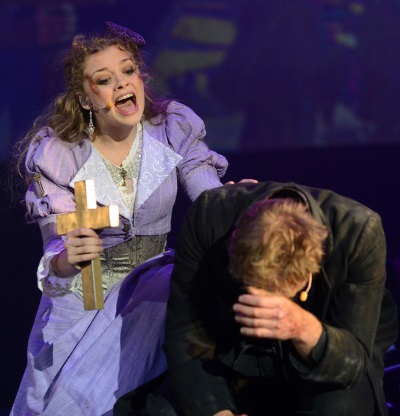
With each act of this production lasting around an hour and containing so many moving parts (including a fire-breathing Martian Fighting Machine), there’s no stop-start like in a rock or pop show, and although most large shows run to timecode for lights and video, it’s not something I’ve ever been involved with. As for reading music, in a rock/pop world of “intro, verse, chorus, verse, chorus, middle eight, double chorus, outro,” I’d never needed to learn.
But when everyone in the room is taking their reference from bar numbers on their music pads, not having access to that is like not speaking the same language. It was time to add another screen to monitor world and have my iPad next to me with the musical score – that way I could at least keep up when someone asked for changes by bar number.
Except that now, in order to fire the snapshot at the right place I would need a way to follow along without having my nose permanently wedged in the iPad. My DiGiCo SD7 console’s video screen on the bridge suddenly became invaluable – I could have the bars and beats reader fed into that so I could easily track where we were.
Problem solved… Except that as the session grew and I added more snapshots (for example, when someone wanted a particular musical phrase boosted wherever it occurred through a movement and then for the levels to return back down), I was spending a lot of time staring at the reader so as not to miss a cue. It was time to embrace timecode.
Clearly it was going to make my life easier, but telling the desk exactly when I wanted it to fire snapshots was going to take time and translation. What I needed to do was sit with (Avid) Pro Tools and input the bar/beat number in question, make a note of the timecode readout at that point, and program it into the desk.
This was no 5-minute job, nor was it for the end of the day – one wrong number would mean a mistake in the firing, so I needed to be sharp when I did the work. Then I needed to sit with the desk for a dry run of the whole show minus any musicians to ensure that I’d got it right. I can’t lie, it was time consuming, but I was so glad I’d put in the work when it was done. Suddenly my hands and eyes were free again!
Further Factors
Still, there was no time to sit back because by now we were in production rehearsals, and that meant it was time to add some more elements – an orchestra, and the guest artists who sing and act throughout the performance.

A theatrical show meant that we were using headworn microphones, which presented an interesting situation. With handheld mics the singer can use mic technique to physically back off or lean in as appropriate, but with headset mics they obviously can’t do that.
I’m not usually a fan of compressing vocals in monitors beyond the subtlest touch, because it can make it hard for someone to find the balance between singing both consistently and dynamically, but here I had to be more aggressive in my approach.
Even so, there’s a limit to how far you can take compression before it sounds squashed, so the console’s DCAs (Digitally Controlled Amplifiers) became my very good friend. It gave me the ability to maintain the human element in Jeff’s mix – if the singers weren’t able to use mic technique, I would effectively do it for them by riding the DCAs.
The final nuance came from the element of noted actor Liam Neeson’s narration. He appears as a hologram throughout the performance to tell the story – not something you encounter on the average rock/pop gig. My DCAs proved useful once more to balance his words against everything else, ducking or boosting one or the other as appropriate between quiet musical passages and those where the full fury of Martian war is unleashed!
Mixing this show challenged me in unexpected ways and inspired new ways of working. I’ve always believed that stepping out of your comfort zone and trying new things is the way to keep growing throughout life and keep it interesting, and the privilege of working on this Martian encounter has greatly enriched me both as an engineer and as a human.
